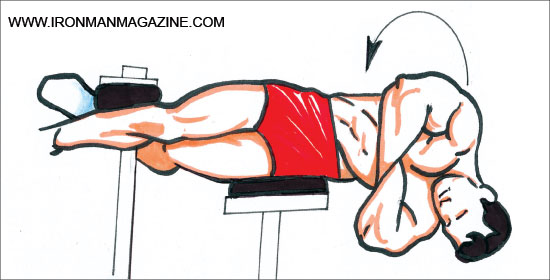
There is an unusual exercise that’s known as the Russian twist. As the name suggests, it’s a combination of exercises. You perform it by positioning yourself sideways on a hyperextension bench with your feet sideways under the footpads. Your upper body is off the bench, hips supported on one side by the torso pad, and you bend your torso toward the floor. It looks similar to a side bend.
When your upper body is at the bottom of the stroke, parallel to the floor on most hyperextension benches, you twist and turn your chest toward the floor. Once you reach a full side bend and twist, you reverse direction and return to the sideways start position at the top of the stroke.
The first person I ever saw do the Russian twist was the late Mike Mentzer at Gold’s Gym. Mentzer positioned himself sideways on the hyperextension bench, and his training partner handed him a 45-pound plate. Mentzer’s side was parallel to the floor, and he was holding the plate at his chest; then he started to bend toward the floor and twist until his chest faced the floor. He performed 15 reps for several sets.
The Russian twist eventually made its way into the popular gym chains. Many trainees saw it as a fun new exercise to try. Regrettably, the problems it can cause became more widespread too. It can lead to back pain, some of which can be managed and some that will require professional health care.
The problem is that the Russian twist places a great deal of shearing stress on the spine’s disks, the shock absorbers between the bony vertebrae. The lower back is not designed to rotate. It’s primarily designed to bend forward and back—flex and extend—a motion that’s determined by the facet joints that guide the motion of the spine. When you’re positioned sideways on the hyper bench, your legs are locked in under the footpads. That restricts the pelvis’ movement because the legs are braced, putting more motion emphasis on the lumbar spine.
The side bend places tension and stress on one side of the disk. When you start to rotate, the tension and stress on the disk increases much more. That’s the way disk injuries or flare-ups of existing disk injuries can occur.
You may notice a dull low-back ache that doesn’t improve or may worsen. Once that pain occurs, you may have difficulty with seated cable rows, squats, deadlifts, stiff-legged deadlifts and even military presses. This type of pain can be from a disk injury or from inflammation and compression of the facet joints. You may experience a sudden, sharp pain in the lower back and possibly one or both legs. Those cases may require a visit to a health-care professional for an evaluation.
No matter which exercise trainees perform and how often they are injured by an exercise, there will always be exceptions. I have no doubt that you know someone who has performed Russian twists without pain or problems—yet. This is an exercise that carries a significant risk of injury.
As always, train smart first and then train hard.
Editor’s note: Visit www.SoftTissueCenter.com for reprints of Horrigan’s past Sportsmedicine columns that have appeared in IRON MAN. You can order the books Strength, Conditioning and Injury Prevention for Hockey by Joseph Horrigan, D.C., and E.J. “Doc” Kreis, D.A., and the 7-Minute Rotator Cuff Solution by Horrigan and Jerry Robinson from Home Gym Warehouse, (800) 447-0008 or at www.Home-Gym.com.




















You must be logged in to post a comment Login